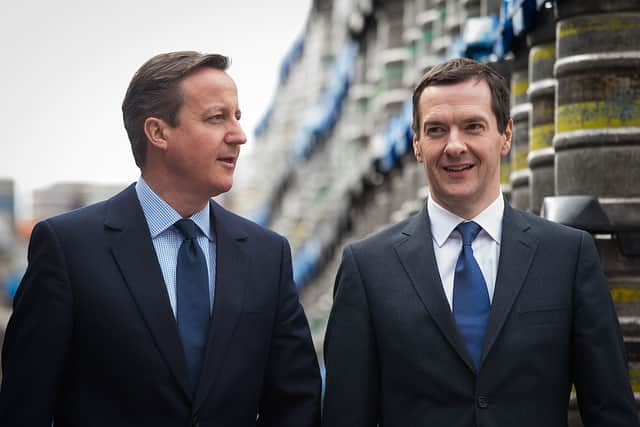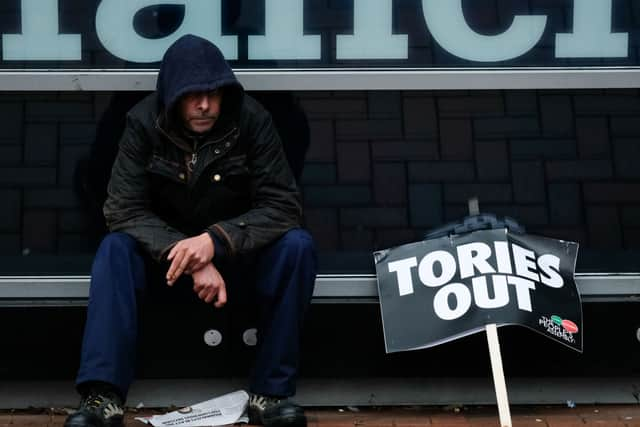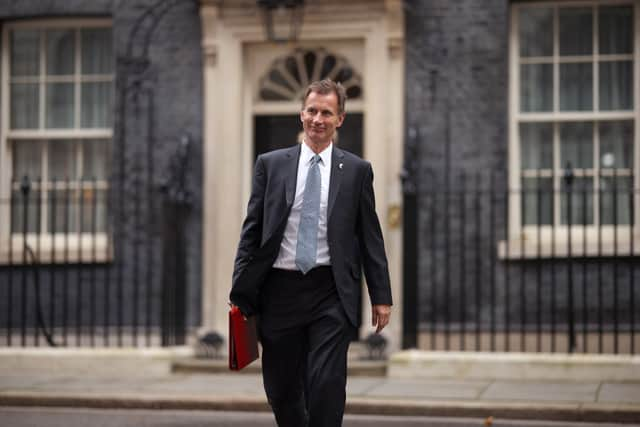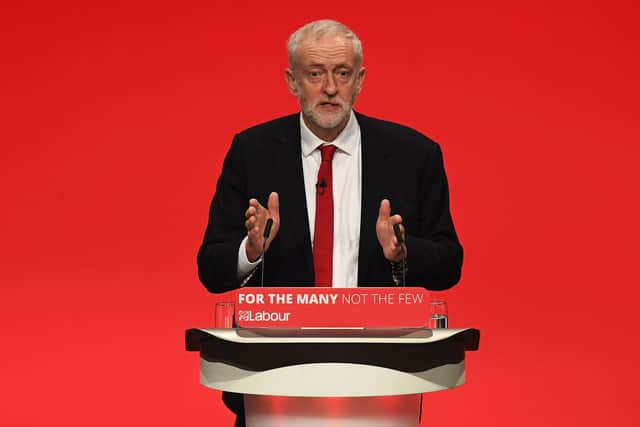What is austerity? What does it mean UK, is it good for economy, what happened last time - ahead of new Budget
This article contains affiliate links. We may earn a small commission on items purchased through this article, but that does not affect our editorial judgement.
and live on Freeview channel 276
The Chancellor of the Exchequer Jeremy Hunt will deliver another budget today (17 November) as the Rishi Sunak administration seeks to rescue the UK economy following the disastrous mini budget announced by Liz Truss and Kwasi Kwarteng.
The previous Conservative government’s swathe of unfunded tax cuts crashed the value of the pound, almost led to a run on pension funds, and has contributed to a big hike in interest rates on mortgages. Government borrowing costs have also become more expensive, making it harder for the current Treasury to bridge a major gap in its balance sheet.
Advertisement
Hide AdAdvertisement
Hide AdWhile Hunt is expected to provide some cost of living support for the UK’s poorest and most vulnerable households, the Chancellor is also going to - in his words - “balance the books” with tax hikes and public spending cuts. It comes after inflation soared again in October 2022, reaching 11.1% on the Office for National Statistics CPI.
The phrase Hunt has used echoed those that were made by David Cameron and his Chancellor George Osborne during the coalition government of the early 2010s. The Conservative-Liberal Democrat administration pursued a policy of austerity after getting into power in the wake of the 2008 financial crisis.
But is austerity - and what does it mean for the UK economy? Here’s what you need to know.


What is austerity?
Austerity is defined by the Cambridge Dictionary as: “The condition of living without unnecessary things and without comfort, with limited money or goods, or a practice, habit, or experience that is typical of this.”
Advertisement
Hide AdAdvertisement
Hide AdA more politics-focused definition of the term is: “A situation in which a government spends as little money as possible because of bad economic conditions.”
Essentially, it is a period of spending cuts or tax hikes or both. A government may consider austerity as a policy if it has been running a budget deficit - i.e. it is having to borrow money to fund public spending - at a rate that is adding to the national debt (the money that builds up after years of deficits) at an unsustainable rate.
Typically, this sort of scenario occurs after a major financial shock. For example, the UK national debt grew massively during World War Two as a result of the country having to run a wartime economy. It led to years of austerity - although it was not as harsh as it was during the 2010s.
What happened under austerity during the 2010s?
When the Conservative-Liberal Democrat coalition government that was headed up by David Cameron came to power in 2010, the economy was in a state of recovery following the 2008 financial crisis. The Conservatives had beaten Labour to become the largest party by rubbishing their rivals’ economic record.
Advertisement
Hide AdAdvertisement
Hide AdCameron’s Chancellor of the Exchequer, George Osborne, set about delivering on the Conservative Party’s pledge to “balance the books” in a bid to reduce the national debt and annual budget deficit. He aimed to achieve this goal by 2016 and turn a surplus by 2020.


Osborne pursued public spending cuts over tax hikes. After raising capital gains tax and VAT, he initially set about:
- Cutting out £6 billion of ‘wasteful’ spending
- Applying a public sector pay freeze that lasted for two years before being capped at 1% (lasted until 2017)
- Welfare spending was reduced on child benefit, housing benefit and family tax credits
He also cut corporation tax in a bid to stimulate economic growth.
The general impact of these and subsequent policies was that public services were hollowed out, the NHS struggled to deliver positive health outcomes, public sector workers saw their real-terms wages decline, and those on benefits saw their incomes drop.


Advertisement
Hide AdAdvertisement
Hide AdAt the same time, the budget deficit fell - albeit to levels that were nowhere near what Osborne had aimed for - and the national debt as a percentage of GDP continued to climb for five out of the six years he was in charge of the UK public finances.
The policy arguably came to an end under the Theresa May government, which spoke about supporting those who were “just about managing”. Austerity’s official death was confirmed when Boris Johnson got into office in 2019 and openly criticised it.
Is austerity good for the UK economy?
Austerity is a divisive policy that is very much a political decision, rather than the only way of solving a country’s economic woes.
While the Cameron government could point to consistent (albeit small) economic growth and record lows of unemployment, its austerity policies increased inequality between the UK’s richest and poorest, increased poverty and homelessness and created a precarious gig economy for workers. So, it was ok if you think economic growth is the most important thing for the government to pursue, but a bad thing if you think the health and wellbeing of the population ought to be the priority.


Advertisement
Hide AdAdvertisement
Hide AdWith interest rates at record lows throughout much of the 2010s and inflation levels remaining at relatively low levels for much of the decade, some economists argued the government could have afforded to borrow and spend more than it did to stimulate better GDP growth. They could also have targeted tax hikes at higher earners to bolster the nation’s finances, something that would have allowed the public to believe the hardship was being shared by all.
Even the International Monetary Fund (IMF), which has been an advocate for austerity in countries it has had to bail out - including Greece and Argentina - warned Cameron and Osborne that they were pursuing too much austerity. The organisation said in 2013 that the economic policy was posing “headwinds” to GDP growth.
Your view of whether austerity was a success or not will depend on your political leanings. The policy did marginally improve some of the UK’s spreadsheet numbers (GDP and the deficit) and contributed towards boosting the wealth of those who own assets, like a home - key things for those on the right who believe in at least some form of trickle down economics.


But austerity also pushed more people into poverty, increased inequality and weakened public services - key issues for those towards the centre and the left. Perhaps the biggest example of how weaker public services have impacted the UK in the wake of the policy came during the Covid-19 pandemic.
Advertisement
Hide AdAdvertisement
Hide AdAfter years of real-terms cuts, NHS and social care services struggled to effectively respond to the virus. This state of affairs contributed to the UK having one of the worst excess death rates in the western world.
Will austerity be different this time?
Whether or not austerity will work better this time around is unclear. On the one hand, Jeremy Hunt - who played a major role in the Cameron-era Cabinet - has to satisfy the markets that the UK is at least trying to get on top of the rampant inflation and incoming recession.
Doing so would help ensure the government can borrow more cheaply in the future, which would enable it to get the UK out of a recession sooner. It would also add to the value of the pound in the short-term, which would help the government in its quest to ease the financial pain for the public.


On the other, the Chancellor must also ensure his version of austerity is fair if the public are to swallow it and vote for the Conservatives in again at the next general election. The lack of perceived fairness was one of the things that drove support for former Labour leader Jeremy Corbyn and his ‘for the many, not the few’ manifesto in 2017.
Advertisement
Hide AdAdvertisement
Hide AdThe Treasury has said it will be: “honest about the challenges, and fair in our solutions” and would work to “protect the vulnerable, because to be British is to be compassionate.” But the Rishi Sunak government has a mountain to climb to convince voters that the Tories will not repeat the mistakes they made in the past.
Comment Guidelines
National World encourages reader discussion on our stories. User feedback, insights and back-and-forth exchanges add a rich layer of context to reporting. Please review our Community Guidelines before commenting.
